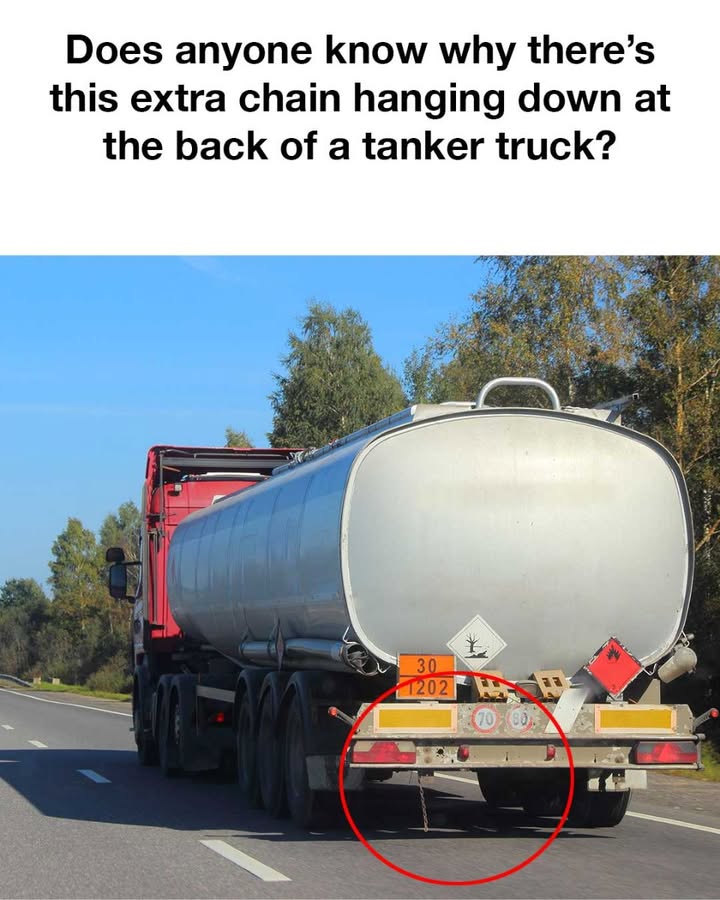The Hidden Safety Feature on Tanker Trucks: The Extra Chain Explained

Tanker trucks are specialized vehicles designed to transport liquids and gases such as fuel, water, chemicals, and food-grade products. These trucks feature a large cylindrical tank mounted on a chassis, engineered for the safe transportation of these substances. While their design includes many safety components, one small but crucial detail often goes unnoticed—the extra chain hanging from the back of the truck. Though it may seem insignificant, this chain serves an important safety purpose.
Why Do Tanker Trucks Have an Extra Chain?
The chain hanging from the rear of a tanker truck functions as a grounding device, helping to prevent dangerous static electricity buildup. As the truck moves, friction between the liquid and the tank, along with the truck’s motion, generates static electricity. If this static charge is not properly discharged, it could lead to a spark—posing a serious fire or explosion risk, especially when transporting flammable substances like fuel. The chain drags along the ground, providing a continuous path for static electricity to safely dissipate, reducing the chance of ignition.
The History Behind Grounding Chains
The need for grounding chains became evident as fuel transportation expanded. In the early days, static-related fires and explosions were more common, leading to catastrophic accidents. As safety regulations evolved, the grounding chain emerged as a simple yet effective solution. Over time, it became a standard safety feature on tanker trucks worldwide, reinforced by industry standards and government regulations.
Safety Regulations and Compliance
Transporting hazardous materials requires strict adherence to safety regulations. Organizations like the U.S. Department of Transportation (DOT) and similar agencies worldwide enforce guidelines covering everything from tank construction to pressure limits and static electricity management. Grounding chains are mandatory safety features, regularly inspected to ensure they remain in good condition. Compliance with these regulations helps prevent accidents and ensures public safety.
The Science of Static Electricity in Fuel Transport
Static electricity occurs when two surfaces make contact and then separate, causing an imbalance of electric charges. In fuel transport, the movement of liquid inside the tank generates static due to friction. If the static is not discharged, even a small spark can ignite fuel vapors, leading to a fire or explosion. The grounding chain prevents this by continuously transferring excess static charge to the ground, making fuel transport significantly safer.
Are There Alternatives to Grounding Chains?
While grounding chains remain a widely used safety measure, newer technologies are also in place:
- Static grounding reels: Retractable cables that attach to a grounding point during loading and unloading.
- Anti-static additives: Chemicals mixed into fuel to reduce static buildup.
- Advanced tank coatings: Special materials designed to minimize friction and static electricity.
These alternatives are often used alongside grounding chains for an added layer of safety.
Common Myths About the Extra Chain
There are several misconceptions about the chain on tanker trucks:
❌ “It’s just a leftover piece of equipment.” – No, it’s an essential safety feature.
❌ “It helps stabilize the truck or assist with braking.” – It has nothing to do with truck stability or braking.
❌ “Modern technology has made it obsolete.” – While newer solutions exist, grounding chains remain a simple, effective, and widely used method for dissipating static electricity.
Preventing Accidents: The Role of the Grounding Chain
The grounding chain significantly reduces the risk of static-related accidents. By continuously providing a path for static discharge, it helps prevent fires and explosions, ensuring safer transportation of flammable substances. This small but crucial feature protects truck drivers, transport workers, and the general public.
Maintenance and Inspection: Ensuring Effectiveness
Regular maintenance is key to keeping the grounding chain functional. Over time, chains can become worn, corroded, or damaged, affecting their ability to discharge static electricity. Routine inspections ensure the chain remains in good condition and in constant contact with the ground. If damage is detected, the chain must be replaced to maintain safety.
Final Thoughts: A Small Chain with a Big Impact
The extra chain hanging from a tanker truck may seem like a minor detail, but it plays a critical role in preventing static-related accidents. By allowing static electricity to safely dissipate, this simple safety feature reduces the risk of fires and explosions during the transportation of hazardous materials. Despite advancements in fuel transport technology, grounding chains remain an essential component of tanker truck safety, backed by industry regulations and best practices.
Understanding and maintaining this feature is key to ensuring safe, reliable, and efficient fuel transport.